A binary puzzle, demystified
Let’s take a look at the cards again.
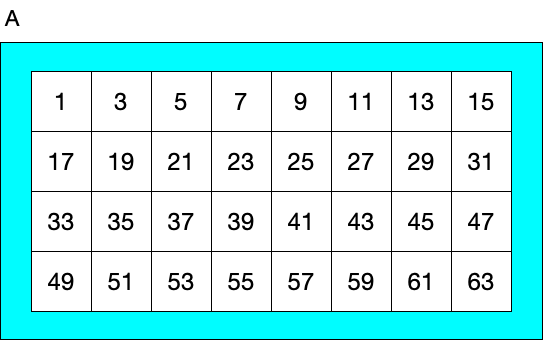

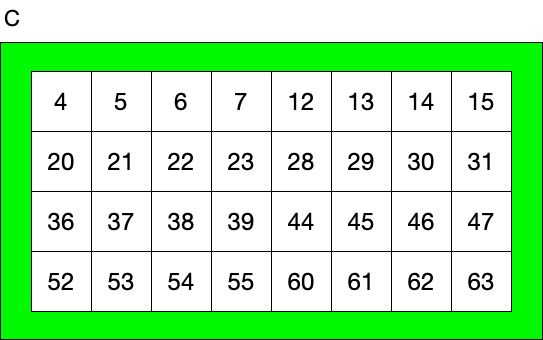
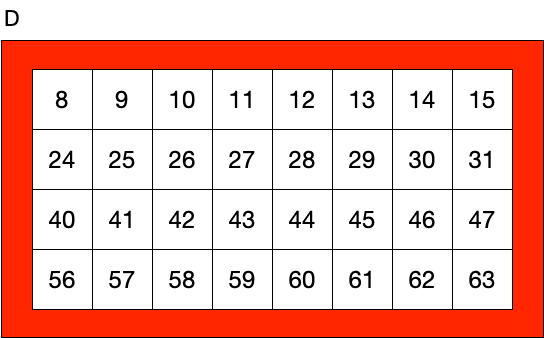
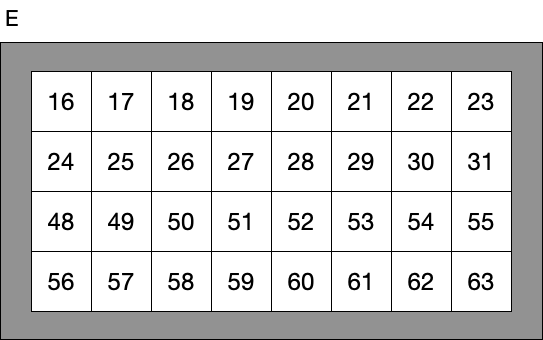
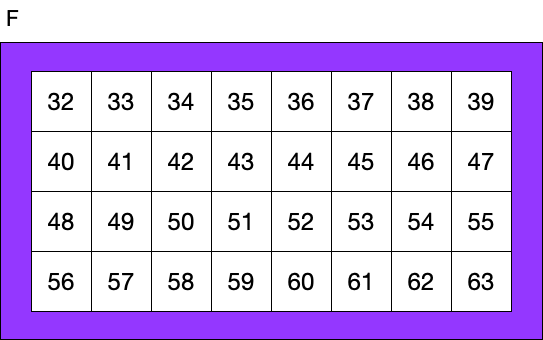
Clearly the numbers range from one to 63, and each card has exactly 32 numbers on it.
But how are the numbers organized? Why, for example, is 55 on cards A, B, C, E, and F, but not on card D? Why, for example, is 9 only on cards A and D?
Consider the binary representation of numbers from one to 63.
| dec | bin | dec | bin | dec | bin | dec | bin | |||
|---|---|---|---|---|---|---|---|---|---|---|
| 16 | 010000 | 32 | 100000 | 48 | 110000 | |||||
| 1 | 000001 | 17 | 010001 | 33 | 100001 | 49 | 110001 | |||
| 2 | 000010 | 18 | 010010 | 34 | 100010 | 50 | 110010 | |||
| 3 | 000011 | 19 | 010011 | 35 | 100011 | 51 | 110011 | |||
| 4 | 000100 | 20 | 010100 | 36 | 100100 | 52 | 110100 | |||
| 5 | 000101 | 21 | 010101 | 37 | 100101 | 53 | 110101 | |||
| 6 | 000110 | 22 | 010110 | 38 | 100110 | 54 | 110110 | |||
| 7 | 000111 | 23 | 010111 | 39 | 100111 | 55 | 110111 | |||
| 8 | 001000 | 24 | 011000 | 40 | 101000 | 56 | 111000 | |||
| 9 | 001001 | 25 | 011001 | 41 | 101001 | 57 | 111001 | |||
| 10 | 001010 | 26 | 011010 | 42 | 101010 | 58 | 111010 | |||
| 11 | 001011 | 27 | 011011 | 43 | 101011 | 59 | 111011 | |||
| 12 | 001100 | 28 | 011100 | 44 | 101100 | 60 | 111100 | |||
| 13 | 001101 | 29 | 011101 | 45 | 101101 | 61 | 111101 | |||
| 14 | 001110 | 30 | 011110 | 46 | 101110 | 62 | 111110 | |||
| 15 | 001111 | 31 | 011111 | 47 | 101111 | 63 | 111111 |
Now let’s focus on the numbers that appear on card A.
| dec | bin | dec | bin | dec | bin | dec | bin | |||
|---|---|---|---|---|---|---|---|---|---|---|
| 16 | 010000 | 32 | 100000 | 48 | 110000 | |||||
| 1 | 000001 | 17 | 010001 | 33 | 100001 | 49 | 110001 | |||
| 2 | 000010 | 18 | 010010 | 34 | 100010 | 50 | 110010 | |||
| 3 | 000011 | 19 | 010011 | 35 | 100011 | 51 | 110011 | |||
| 4 | 000100 | 20 | 010100 | 36 | 100100 | 52 | 110100 | |||
| 5 | 000101 | 21 | 010101 | 37 | 100101 | 53 | 110101 | |||
| 6 | 000110 | 22 | 010110 | 38 | 100110 | 54 | 110110 | |||
| 7 | 000111 | 23 | 010111 | 39 | 100111 | 55 | 110111 | |||
| 8 | 001000 | 24 | 011000 | 40 | 101000 | 56 | 111000 | |||
| 9 | 001001 | 25 | 011001 | 41 | 101001 | 57 | 111001 | |||
| 10 | 001010 | 26 | 011010 | 42 | 101010 | 58 | 111010 | |||
| 11 | 001011 | 27 | 011011 | 43 | 101011 | 59 | 111011 | |||
| 12 | 001100 | 28 | 011100 | 44 | 101100 | 60 | 111100 | |||
| 13 | 001101 | 29 | 011101 | 45 | 101101 | 61 | 111101 | |||
| 14 | 001110 | 30 | 011110 | 46 | 101110 | 62 | 111110 | |||
| 15 | 001111 | 31 | 011111 | 47 | 101111 | 63 | 111111 |
What do you notice about the highlighted numbers? They’re all odd. How can you tell an odd number in binary? Easy. Just look at the least significant digit—that’s the ones column. If the digit is a 1, then the number is odd. Otherwise the number is even.
So we could say that card A includes all the odd numbers, but for sake of finding the general pattern, let’s say instead that _card A include all the numbers whose binary representation has a 1 in the 2^0 (ones) position.
Now you can probably guess how card B is populated, but look carefully, it’s not just even numbers. Give this a little more thought.
| dec | bin | dec | bin | dec | bin | dec | bin | |||
|---|---|---|---|---|---|---|---|---|---|---|
| 16 | 010000 | 32 | 100000 | 48 | 110000 | |||||
| 1 | 000001 | 17 | 010001 | 33 | 100001 | 49 | 110001 | |||
| 2 | 000010 | 18 | 010010 | 34 | 100010 | 50 | 110010 | |||
| 3 | 000011 | 19 | 010011 | 35 | 100011 | 51 | 110011 | |||
| 4 | 000100 | 20 | 010100 | 36 | 100100 | 52 | 110100 | |||
| 5 | 000101 | 21 | 010101 | 37 | 100101 | 53 | 110101 | |||
| 6 | 000110 | 22 | 010110 | 38 | 100110 | 54 | 110110 | |||
| 7 | 000111 | 23 | 010111 | 39 | 100111 | 55 | 110111 | |||
| 8 | 001000 | 24 | 011000 | 40 | 101000 | 56 | 111000 | |||
| 9 | 001001 | 25 | 011001 | 41 | 101001 | 57 | 111001 | |||
| 10 | 001010 | 26 | 011010 | 42 | 101010 | 58 | 111010 | |||
| 11 | 001011 | 27 | 011011 | 43 | 101011 | 59 | 111011 | |||
| 12 | 001100 | 28 | 011100 | 44 | 101100 | 60 | 111100 | |||
| 13 | 001101 | 29 | 011101 | 45 | 101101 | 61 | 111101 | |||
| 14 | 001110 | 30 | 011110 | 46 | 101110 | 62 | 111110 | |||
| 15 | 001111 | 31 | 011111 | 47 | 101111 | 63 | 111111 |
These are all the numbers that have a 1 in the 2^1 column—the twos column. These are all the numbers on card B.
Here’s a table indicating which cards only contain numbers with a 1 in the indicated (binary) position.
| card | 2^5 (32) | 2^4 (16) | 2^3 (8) | 2^2 (4) | 2^1 (2) | 2^0 (1) |
|---|---|---|---|---|---|---|
| A | ||||||
| B | ||||||
| C | ||||||
| D | ||||||
| E | ||||||
| F |
- Card A contains all the numbers that have a 1 in the 2^0 column.
- Card B contains all the numbers that have a 1 in the 2^1 column.
- Card C contains all the numbers that have a 1 in the 2^2 column.
- Card D contains all the numbers that have a 1 in the 2^3 column.
- Card E contains all the numbers that have a 1 in the 2^4 column.
- Card F contains all the numbers that have a 1 in the 2^5 column.
So, 55 (binary 110111) appears on all the cards but D, because it has 1s in all the columns except the 2^3, 9 (binary 001001) appears only on cards A and D, because its binary representation has 1s only in the 2^0 column and the 2^3 column, and good old 42 appears on cards B, D and F because its binary representation (101010) has 1s only in the 2^1, 2^3, and 2^5 columns. The point is that the cards on which a number appears uniquely specifies those columns which have a one. If you know what cards a number appears on, you can uniquely determine the number.
Notice that the upper left-hand number on each card is a power of two.
| card | number |
|---|---|
| A | 1 |
| B | 2 |
| C | 4 |
| D | 8 |
| E | 16 |
| F | 32 |
If your friend tells you their number is on cards A, B, C, and F, add: 1 + 2 + 4 + 32 = 39. If your friend tells you their number is only on card C, you know it must be 4. If your friend tells you their number is on all cards, then add: 1 + 2 + 4 + 8 + 16 + 32 = 63.
Check-in
- Without looking at the cards, say which cards the following numbers are on:
- 17
- 31
- 45
- Explain why there are exactly 32 numbers on each card.
- Explain why zero doesn’t appear on any card.
- Explain why this game won’t work with octal or decimal—or any other base beside two.
Beyond positive integers
As we move beyond positive integers, we’ll need some new ways to represent negative numbers. For this game, they are excluded.
© 2025 Clayton Cafiero.
No generative AI was used in producing this material. This was written the old-fashioned way.